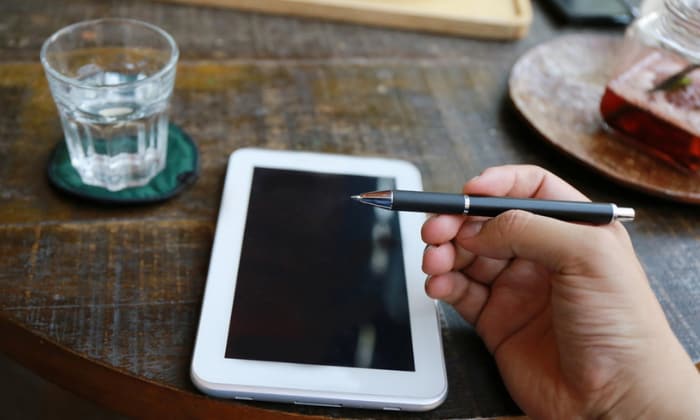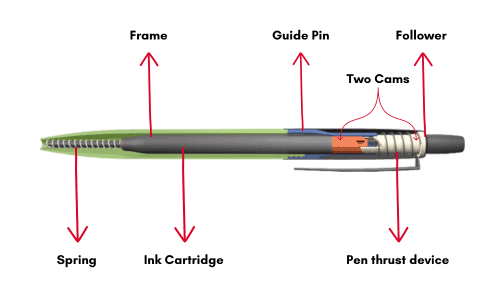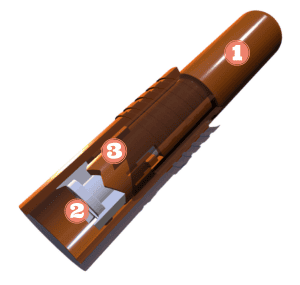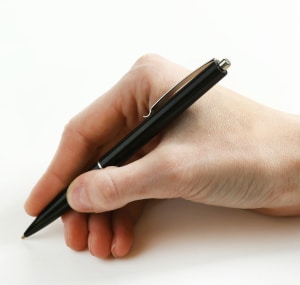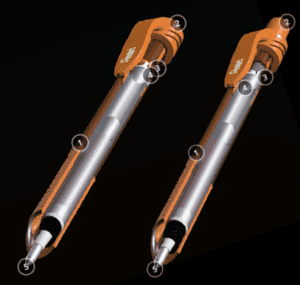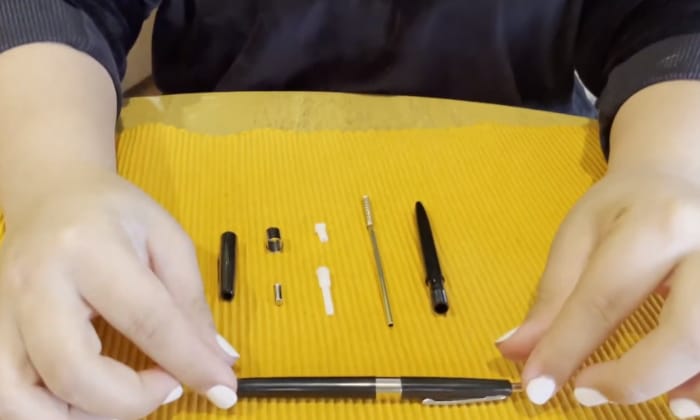Have you ever wondered how does a click pen work? The answer lies in the ingenious mechanism behind it.
A click pen operates through a combination of clever components, including a spring-loaded system and a thrust device. These work together to make the pen tip protrude and retract back into the body with 2 clicks.
To unravel the secrets of this everyday marvel, keep reading to discover the fascinating inner workings of a click pen.
Table of Contents
What is a Click Pen?
A click pen, also known as a retractable pen, is a type of ink pen that has a spring-loaded mechanism that retracts and extends the pen tip.
The purpose of a click pen is primarily convenience and functionality. The retractable pen click mechanism eliminates the need for a cap, making the pen easier to use with just one hand. This can be especially useful when the user is multitasking or needs to quickly jot something down.
Moreover, when the tip is retracted, it prevents the ink from drying out. Also, it avoids any accidental stains or leaks in your bag, pocket, or paper when the pen is not in use.
History of click pen
In 1888, John J. Loud invented the first ballpoint pen. However, it proved ineffective on paper.
The subsequent 30 years saw various attempts to refine the design, but the pens were prone to leaks and deterioration. It was not until the 1930s that László Bíró created the first smudge-free ballpoint pen.
Entrepreneur Milton Reynolds took advantage of Bíró’s design to manufacture a product known as the Reynolds Rocket. However, Bíró’s and Reynolds’ pens had one significant limitation – they required a cap.
In the 1950s, the first retractable click ballpoint pen was introduced by the Frawley Pen Company. This time was considered the golden era that transformed the landscape of writing implements.
Anatomy of click pen
Here are the main parts of a retractable pen!
- Frame: The frame of a pen contains the ink cartridge and spring mechanism and other parts.
- Pen thrust device: This is a part of the clicking mechanism. It’s usually a small piece that’s pressed to move the other mechanism parts, thus extending or retracting the pen tip. When you press the top of a click pen, you’re pressing the thrust device.
- Two Cams: In a click pen, the cams are shaped so that they can keep the pen tip in place either inside or outside the pen body. When you press the thruster, it turns the cams, changing their position and the state of the pen tip.
- Guide Pin: The guide pin works in conjunction with the cams to accurately direct the movement of the pen tip. The guide pin fits into a groove or track in the cam mechanism, ensuring the smooth operation of the system.
- Follower: The follower is either affixed to the pen refill’s top or slotted into the pen’s upper section. It performs the critical task of driving the motion of the pen’s nib, guided by the movements of the cam.
- Spring: The spring in a click pen is crucial for its operation. It provides the necessary force to push the ink cartridge back when you press the thruster, which retracts the pen tip.
- Ink Cartridge: The ink cartridge holds the ink used for writing. It has a narrow tube that extends to the pen tip, allowing ink to flow down to the paper when pressure is applied.
The Click Mechanism
The click mechanism is an integral part of retractable pens, including ballpoint pens, rollerball pens, gel pens, and stylus pens. Though different types of retractable pen may have slightly different mechanisms, they often share a common structure.
Let’s explore the retractable pen mechanism with the 3D model of a Pentel ballpoint pen!
1. Key components
The click mechanism comprises three main components:
- Push Button
- Follower
- Cam
2. Nib positions
- P1: The nib is inside of a pen.
- P2: Upon clicking, the nib extends to its maximum point (1st click).
- P3: The nib slightly retracts and remains extended (2nd click).
- P4: After pressing again, the nib moves out to position 4 (3rd click).
- P5: The nib fully retracts (4th click sound).
So, with one click to extend the tip and another to retract it, there occur 4 distinct click sounds.
3. How the click pen works
In the initial position, the follower is entirely within the pen. After you click the push button, the follower – the white part in the 3D model – moves upwards from its position within the cam, causing the tip to protrude to its maximum position.
This movement is possible due to the consistent upward force applied by the pen’s internal spring, which also imparts a 45-degree rotation to the cam. The first click occurs.
After releasing the push button, the cam comes into contact with the guide and slides back again. This motion causes the nib to retract slightly and results in a 2nd click sound.
The cycle restarts when you push pens button again. The follower moves to its maximum extension. This time, however, upon releasing the push rod, the nib doesn’t stay extended. The follower, under the pressure of the spring, returns next to the cam, leading to the retraction of the pen’s refill.
You can hear the fourth click as the nib fully retracts back into the pen.
To visualize the ballpoint pen mechanism at work, you can find the 3D model that shows the total view of the pen.
Related: How Does a Ball Point Pen Work?
Pen Clicking Psychology
Pen clicking, a common habit for many people, is often linked to a psychological need for mental and physical stimulation.
In psychology, the act of clicking a pen repetitively can be seen as a manifestation of nervous energy. This behavior could be a response to anxiety or discomfort in certain situations, providing a sense of relief to the individual.
Therefore, despite sometimes being seen as a distracting or annoying habit, pen clicking can help individuals focus or manage feelings.
Frequently Asked Questions
Common Issues And Troubleshooting
- Jammed Mechanism: If the click mechanism is stuck, gently tapping the pen against a hard surface can often dislodge any obstructions.
- Pen Not Writing: If the pen isn’t writing, the ink may have dried at the tip. Scribbling on a piece of scratch paper can often get the ink flowing again. If this doesn’t work, the pen may be out of ink.
- Unresponsive Click Mechanism: If the pen doesn’t click or the nib doesn’t retract or extend properly, it might be due to a misalignment of internal components. In such cases, carefully disassembling and reassembling the pen can resolve the issue.
How To Fix A Retractable Ballpoint Pen?
The process of fixing a retractable ballpoint pen largely depends on the specific issues it’s experiencing.
For example, if the pen is not clicking properly, you can follow these steps to make a pen work:
- Disassemble the pen carefully to expose the click mechanism.
- Check for any visible misalignment or damage in the internal components – mainly the push button, follower, and cam.
- Correctly realign any misplaced parts, ensuring the follower is properly interacting with the cam.
- Reassemble the pen and test the click action. If the problem persists, you may need to replace the click mechanism or refill the pen if it’s out of ink.
Conclusion
Now you know how does a click pen work, in fact, the click mechanism of a pen is a fascinating blend of engineering and design. It involves the intricate interplay of components like the push button, follower, and cam.
With each click, these parts move in a predefined cycle, causing the nib to extend and retract. The spring’s force ensures the follower’s accurate movement along the cam’s profile, facilitating a smooth and reliable clicking action.

Art has always been a part of my life; it influences my upbringing and later my career choice. For me, it is always a part of my parenting technique. So for whichever purpose that you come to art, you can start here with us.

